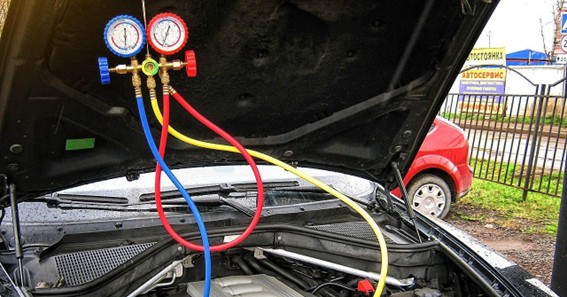🌬️ The Role of AC Refrigerant in Your Car
The AC refrigerant in your car is crucial for maintaining a comfortable cabin temperature, especially during hot weather. It circulates through the air conditioning system, absorbing heat from the interior and releasing it outside, thus cooling the air inside your vehicle.
❄️ Types of Car AC Refrigerants
R-134a (HFC-134a)
Introduced in the early 1990s as a replacement for the ozone-depleting R-12, R-134a became the standard refrigerant for many vehicles. While it doesn’t harm the ozone layer, it has a high Global Warming Potential (GWP) of 1,430. Vehicles manufactured between 1994 and 2014 predominantly use R-134a.
R-1234yf (HFO-1234yf)
As environmental concerns grew, R-1234yf emerged as a more eco-friendly alternative with a GWP of less than 1. Many vehicles produced after 2015, especially in the U.S., have adopted this refrigerant. It’s essential to note that R-1234yf is not interchangeable with R-134a due to differences in chemical properties and system requirements.
🔍 Identifying the Right Refrigerant for Your Vehicle
To determine the appropriate refrigerant for your car:
- Check Under the Hood: Most vehicles have a label indicating the type of refrigerant used.
- Consult the Owner’s Manual: The manual provides detailed information about the AC system specifications.
- Professional Inspection: If in doubt, a certified mechanic can identify the correct refrigerant type for your vehicle
⚠️ Signs Your Car’s AC Refrigerant May Be Low
Recognizing the symptoms of low refrigerant can prevent further damage to your AC system:
- Warm Air from Vents: If the AC isn’t blowing cold air, it might indicate low refrigerant levels.
- AC Clutch Not Engaging: The compressor clutch may fail to engage if there’s insufficient refrigerant.
- Cooling Only While Driving: The AC might only cool the cabin when the car is in motion, suggesting a low refrigerant charge.
- Foggy Windows: AC systems help dehumidify the air; if windows remain foggy, it could be due to low refrigerant.
- Recent AC Repairs: After replacing AC components, a recharge is often necessary as refrigerant can escape during repairs.
🛠️ Checking and Recharging Your Car’s AC Refrigerant
While some car owners opt for DIY recharge kits, it’s crucial to approach this task with caution:
- Use the Correct Refrigerant: Ensure you’re using the type specified for your vehicle.
- Avoid Overcharging: Adding too much refrigerant can damage the AC system.
- Professional Service: For accurate diagnostics and safe handling, consider seeking professional assistance.
🧰 Maintenance Tips for Optimal AC Performance
- Regular Inspections: Have your AC system checked periodically to detect potential issues early.
- Clean the Condenser: Remove debris and dirt to ensure efficient heat exchange.
- Replace Cabin Air Filters: A clogged filter can reduce airflow and strain the AC system.
- Run the AC Periodically: Even in colder months, running the AC helps maintain system lubrication and prevents seals from drying out.
FAQ
Q1: Can I mix R-134a and R-1234yf refrigerants?
A: No, mixing different refrigerants can damage the AC system and is not recommended.
Q2: How often should I recharge my car’s AC refrigerant?
A: Typically, AC systems don’t require frequent recharging unless there’s a leak or after specific repairs.
Q3: Is it safe to recharge the AC refrigerant myself?
A: While DIY kits are available, improper handling can lead to system damage. It’s advisable to consult a professional.
Q4: What causes refrigerant leaks in car AC systems?
A: Common causes include worn seals, damaged hoses, or corrosion in the system components.
Q5: Does low refrigerant affect fuel efficiency?
A: Yes, an underperforming AC system can strain the engine, potentially reducing fuel efficiency.
Understanding the importance of AC refrigerant in your car ensures a comfortable driving experience and prolongs the lifespan of your vehicle’s air conditioning system. Regular maintenance and timely interventions can prevent costly repairs and keep your AC running efficiently.










